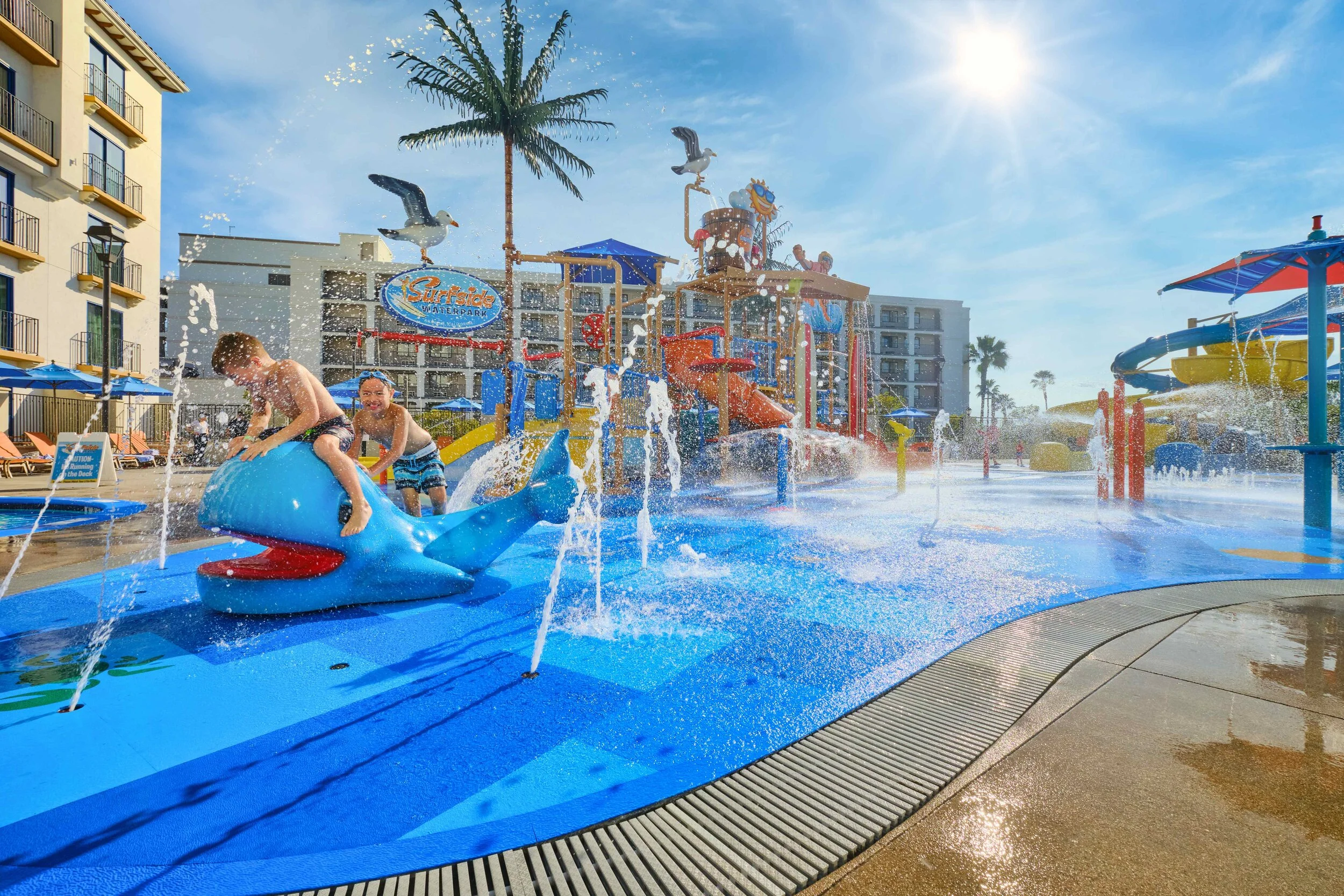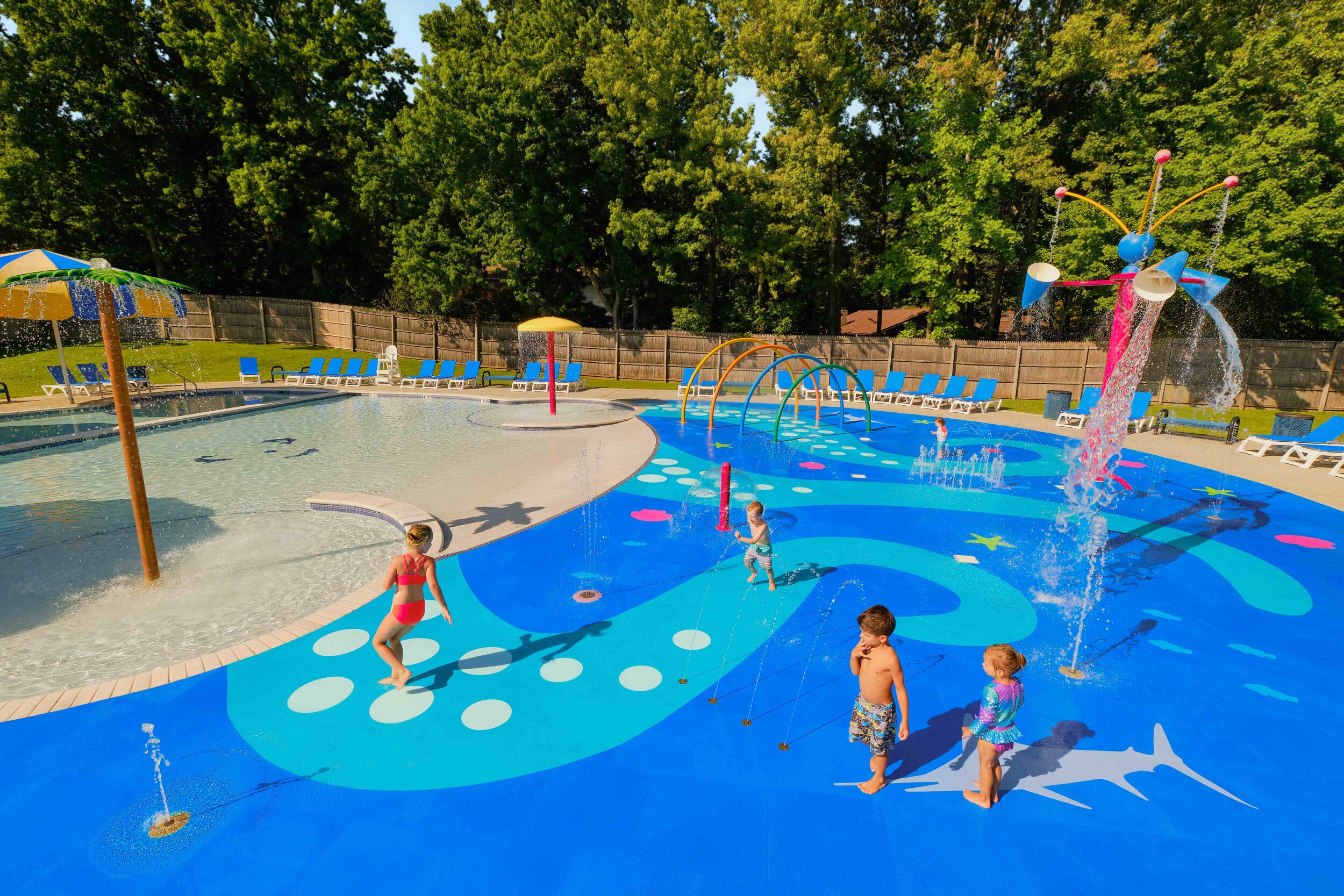Playgrounds and splash pads are designed with very similar intentions in mind. Both provide play features and open spaces that encourage imaginative exploration, running, and risky play opportunities. Playgrounds feature spring riders, slides, and play panels whereas splash pads feature spray jets, dump buckets, and water slides. However, where playgrounds require safety surfacing, splash pads are still being commonly surfaced with unforgiving concrete, tile, or stone. If splash pads are essentially wet playgrounds (leaving visitors more prone to accident and injury), how are hard and slick surfacing options still permitted?
WHY DON’T WE OFTEN SEE SAFETY SURFACING AT SPLASH PADS IF THEY’RE PLAYGROUNDS TOO?
Our industry has become so accustomed to seeing concrete and failing substrates that it has ignored the problem at splash pads. Many people believe that concrete isn’t an issue at all and that it’s perfectly safe for aquatic play areas. They are likely similar to the people who said concrete was perfectly safe for dry playgrounds too. It took 78 years from the time dry playgrounds were first introduced in 1903 for the Consumer Product Safety Commission to publish the Handbook for Public Playground Safety in 1981.
78 years of avoidable injuries.
Let’s not make that same mistake with splash pads.
A SPLASH PAD SAFETY SURFACING STANDARD DOES EXIST
In 2019, after four years of research, testing, and careful deliberation, NSF International passed NSF/ANSI/CAN Standard 50:26. Recognizing that splash pads function as wet playgrounds, this is the first standard to address the safety of surfaces at interactive water play venues.
The standard cites 6 criteria that products must meet to become certified:
Slip Resistance
Slip-and-fall accidents are one of the top injuries that aquatic facilities report. Most injuries are due to slippery surfacing such as concrete or ceramic tile. Slip-resistance was included in the standard as a feature that certified surfaces should have in order to reduce the number of injuries as a direct result. Certified surfaces are slip-resistant to minimize slip-and-fall injuries. Meeting the criteria requires a 40 British Pendulum Number (BPN) and a P4 on the Australian Standard. Life Floor exceeds this criteria with a 65 BPN and P5 rating.
Impact Absorption
It’s inevitable that falls will happen regardless of slip-resistance since tripping or becoming unbalanced and falling also happens. To address this, impact absorption (also known as cushioning), was added to the standard to protect falls. The standard requires a Head Injury Criterion (HIC) maximum value of 750, with a 0.20 meter (0.66 ft) minimum fall height. Life Floor is certified to this standard with a 74 HIC which means our standard ⅜” tile recommended for splash pads and pool decks has a 1 ft critical fall height. Most raw eggs won’t break when dropped from waist height.
Impermeability
Impermeability is important so that foreign substances such as sunscreen, fertilizer run-off, and other hazardous substances do not absorb into the tile and cause issues. Life Floor is certified to this criteria with 99.7% Impermeability which contributes to the product’s easy to maintain and cleanable features. The joints between tiles were included in testing and received the same ratings.
Cleanability
Having an easily cleanable surface is important for many facilities since it directly impacts guest experience. Life Floor is made from a closed-cell foam, which means it does not harbor bacteria or support microbial growth. During testing, our tiles showed a 99.9% reduction of bacteria after being sanitized, including the joints of tiles.
UV Resistance
Resistance to UV radiation is essential, as many splash pads experience intense, year-long sun exposure. During testing, erosion is not acceptable if it compromises the surface’s traction and impact attenuation. Life Floor is certified to this standard.
Chemical Resistance
As part of the standard, certified surfaces must remain slip-resistant and impact attenuating properties after undergoing exposure to high chemical shock periods without showing signs of erosion. Unlike ceramic or painted depth markers, our tiles retain color contrast and visual clarity after both UV and chemical exposure which is important for safety messaging and depth markers.
Complying to NSF/ANSI/CAN 50:26 is a best practice that can be followed at facilities in order to reduce risk, improve guest experience, and benefit communities. Since certified products are third party tested through the internationally recognized standard, specifiers and operators have peace of mind knowing that these options are reputable and validated through multiple accredited sources. Even though the standard isn’t a code requirement, it has the potential to influence codes and is recognized as a standard for operational excellence.
We’ve created a free resource for facilities in the U.S. and Canada to help understand what different states and territories mention in their official codes. If you’d like to learn more about how Life Floor is certified to this standard, download our guide here.
To purchase the standard for your office’s or city’s use, visit the official NSF International website here.
Previous Life Floor Blogs related to NSF/ANSI/CAN 50:26:
Taking the Lead in Splash Pad Safety
Splash Pads Need Safety Surfacing: Part 1
Splash Pads Need Safety Surfacing: Part 2
Splash Pads Need Safety Surfacing: Part 3
Splash Pads Need Safety Surfaces: Part 4
Water Safety Month: NSF and Independent Standards
NSF/ANSI 50 Passes Surfacing Standard for Interactive Waterplay Areas
National Water Safety Month: Clean Surfaces Make Aquatic Facilities Safer
National Water Safety Month: Getting Traction on a Slippery Issue





